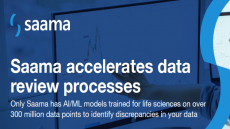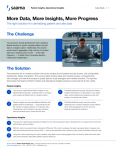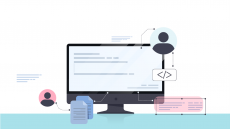Industry united in 2021 to battle significant adversity: Oracle

While the global pandemic created unbelievable obstacles for the industry, many professionals collaborated and innovated to come up with ways to overcome the challenges. Henry McNamara, senior vice president and general manager of Oracle Health Sciences, shared with Outsourcing-Pharma a look back at 2021 and perspective on what 2022 might bring.
OSP: Could you please share your perspective on the biggest issues facing drug developers and their research partners?
HMN: As alternative approaches to clinical trials are adopted and new sources of data emerge, the amount of data that must be analyzed continues to grow. As a result, the burden of data management and analysis is becoming a more urgent challenge to address.
Whether it’s the increased volume and variety of data coming in from wearables, sensors, and other sources used in decentralized clinical trials, or the increased volume of safety cases received by pharmacovigilance teams, the amount of data is far more information than humans can process or manage, and it is also much more complex.
Luckily, great advances have been made in artificial intelligence (AI) and machine learning (ML), which can be applied to automate many data-heavy processes to lessen the pressure on teams that are already spread thin. AI and ML not only process data faster than humans, but they can point to patterns and trends that humans can’t see and will ideally lead to a more accurate and detailed view of how patients are responding in trials, which can lead to better outcomes in the long run.
OSP: Despite formidable challenges (COVID-19 and others), the industry also has made progress. Could you please tell us your thoughts on some of the bright spots, and/or areas of opportunity?
HMN: Throughout the COVID-19 pandemic, we have seen the life sciences industry adapt and evolve rapidly. In an industry traditionally slow to embrace new technologies and approaches, people, organizations, and industries came together, got creative, and worked together to mobilize.
Drug developers and their research partners had to adjust to support alternative ways of monitoring and caring for clinical trial participants in a world where in-person methods were no longer an option. The forced adoption of decentralized clinical trial models has helped the industry understand when and how to implement new approaches to improve clinical research.
Moving forward, the industry has an opportunity to expand trial access to more patients and improve the overall patient experience. A recent Oracle Health Sciences study found 61% of respondents believe allowing patients’ choices will have a positive impact on clinical research and well over half (58%) said that their organizations plan to give patients the option to choose how they participate in clinical trials moving forward.
For example, community sites such as retailers like CVS and Walgreens could become more popular as trial locations. They have been successfully operating as community vaccination sites across the U.S. for flu, COVID-19, and other vaccines. By teaming up with these locations, sponsors can expand opportunities for patient recruitment by offering patients the convenience and comfort of visiting sites they are familiar with and that might be located closer to patients than a hospital or other medical facility.
OSP: Could you please talk a little more about some of the notable findings in your recent survey, and what they might mean for the future of the industry?
HMN: At the onset of the pandemic, the industry had to quickly adapt to keep trials afloat. Methods and technology that were being explored pre-pandemic -- from remote monitoring to video visits to phone visits, eConsent and EHR -- have come front and center during the past 18 months, with an overwhelmingly positive impact.
Our recent survey revealed that 82% of respondents feel that the new clinical trial approaches they adopted during the pandemic have had a positive impact on clinical trials overall, with 26% reporting a “significantly” positive impact.
Even more importantly, the industry is confident in the data generated from newly adopted clinical trial approaches. When asked about their confidence in the data generated by newly adopted approaches, such as eConsent and remote monitoring, 92% of respondents stated they were equally or more confident in the data collected from these methods, compared to data collected via pre-pandemic methods.
This was a marked change from our 2020 survey when nearly half of the respondents said that data reliability and quality (50%) and data collection (45%) were key concerns in adopting decentralized clinical trials. This significant increase in confidence supports the industry’s continued progress towards more decentralized models.
Ultimately, the survey showed that newly adopted clinical trial methods are here to stay -- 97% of companies who implemented new clinical trial methods during the pandemic indicated their organization will continue using at least one of these new methods.
OSP: What is Oracle Health Sciences doing to prepare professionals in the field to meet the obstacles and challenges that might be ahead in 2022? Please feel free to talk about general strategy or specific solutions you might be planning to unveil.
HMN: Throughout the past 20 years as an early pioneer in eClinical technologies, Oracle Health Sciences has come to understand the technology needs from the simplest trials to the most complex, across all therapeutic areas. But we also know that today study teams are under pressure to conduct trials quickly, even with the growing complexity of managing clinical trials resulting from the exponential increase in data.
To meet these demands, study teams need platforms that can offer a streamlined, harmonized, and trustworthy view of data that provides actional insight and reduces process redundancies. Such platforms need to provide unified workflow capabilities such as a single study build, self-service control, and event-based data collection, to be a single source of truth.
For example, with Clinical One, data collection activity happens in the same environment as randomization and trial supply management activity. This enables sites to randomize and collect patient data in one place, allowing for more efficient, accurate data processing and analysis.
A major component of Clinical One is the ability to support data collection from any source, which allows users to collect, monitor, and view data regardless of where it comes from — forms, wearable sensors, patient apps, electronic health records (EHR), labs — in a single, harmonized place. This expanded data gives sites and study teams a more complete picture of the patient’s experience, and ultimately, the safety and efficacy of the investigative therapy, allowing them to make better decisions throughout the trial life cycle.
OSP: Do you have anything to add?
HMN: While the forced adoption of hybrid and decentralized models during the pandemic was unprecedented, the shift highlighted the impact that technology and software can have on the ongoing advancement of clinical trials and drug development. As companies have adopted innovative approaches to clinical trials through the pandemic, we’ve proven the technology and software to support these changes in clinical trial research exists and will continue to propel the industry forward.
As clinical trials continue to evolve, study teams can be confident that technology will help improve processes and not hinder them.



















